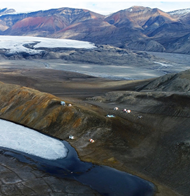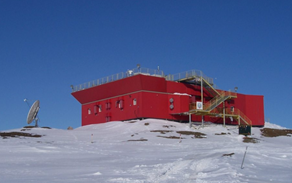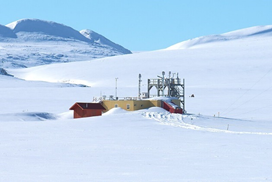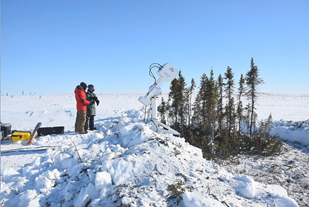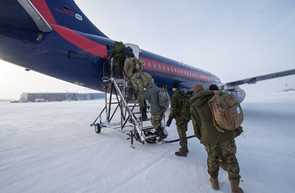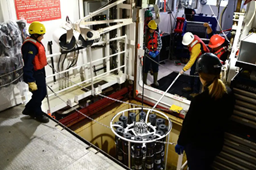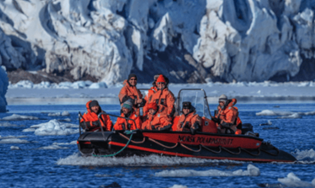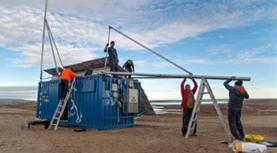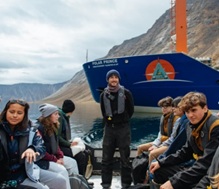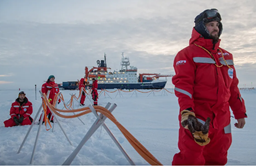Canada operates a fleet of icebreakers through the Canadian Coast Guard (CCG) to ensure safe navigation, support scientific research, and assert sovereignty in Arctic waters. These vessels are categorized based on their icebreaking capabilities and operational roles.
The Canadian Coast Guard currently has 18 icebreakers of varying sizes and capabilities, making it the second-largest icebreaking fleet in the world.
Current Fleet Information
For a complete list of all current and retired vessels operated by the Canadian Coast Guard, please refer to:
Upcoming Vessels
In May 2021, Canada announced the construction of 2 new polar icebreakers under the NSS at Seaspan's Vancouver Shipyards Co. Ltd. and Chantier Davie Canada Inc. Both polar icebreakers will have capacity and abilities beyond those of Canada's current largest icebreaker, the Canadian Coast Guard Ship Louis S. St-Laurent.
In addition to the 2 polar icebreakers, Canada is building:
- 6 Arctic and offshore patrol ships (AOPS) for the Royal Canadian Navy
- 2 AOPS for the Canadian Coast Guard
- 6 program icebreakers
- Up to 16 multi-purpose vessels, all of which have varying icebreaking capabilities
Source: Canada signs new partnership agreement with United States and Finland to produce Arctic and polar icebreakers - Canada.ca
Future Developments
To bolster its Arctic presence, Canada has announced plans to construct new polar icebreakers:
CCGS John G. Diefenbaker: This forthcoming heavy polar icebreaker is intended to replace CCGS Louis S. St-Laurent. Construction has faced delays, with the vessel now expected to enter service in the early 2030s.
Table 1- Heavy Icebreakers
|
CCGS Louis S. St-Laurent (heavy icebreaker) |
CCGS Terry Fox (heavy icebreaker) |
| Image |

|
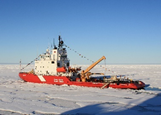
|
| Date of Launch |
1968 |
1983 |
| Introduction |
Commissioned in 1969, this is Canada's largest and most powerful conventional icebreaker. It has undergone several refits to extend its service life and continues to operate in the Arctic, supporting scientific missions and maintaining year-round presence. |
CCGS Terry Fox is homeported in St. John's, Newfoundland and Labrador and operates in the Gulf of St. Lawrence during the winter ice season and in Canada's eastern Arctic during the summer shipping season, assisting in escorting the annual Arctic summer sealift to coastal communities. |
| Dimensions(m) |
Length: 119.6 m
Breadth: 24.4 m
Draft: 9.9 m |
Length: 88 m
Breadth: 17.8 m
Draft: 8.3 m |
| Gross tonnage(ton) |
11,345 tons |
4,234 tons |
| Icebreaker Engineering Details (from Canada.ca) |
https://inter-l03.dfo-mpo.gc.ca/fdat/vessels/report/81 |
https://inter-l03.dfo-mpo.gc.ca/fdat/vessels/report/108 |
Table 2 - Medium Icebreakers
|
CCGS Amundsen (medium icebreaker) |
CCGS Captain Molly Kool (medium icebreaker) |
CCGS Des Groseilliers (medium icebreaker) |
CCGS Pierre Radisson (medium icebreaker) |
| Image |

|

|

|

|
| Date of Launch |
1979 |
2001 |
1997 |
1978 |
| Introduction |
The vessel was recommissioned into the Canadian Coast Guard as Amundsen, named in honour of Arctic explorer Roald Amundsen, on 26 August 2003. Amundsen's sponsor was Lily Schreyer, the sponsor of Franklin when the vessel first entered service. The ship remained the property of the Canadian Coast Guard and continues to support Coast Guard functions but is the dedicated science platform for scientists in the Arctic. |
CCGS Captain Molly Kool is a Canadian Coast Guard converted medium class icebreaker. She was originally built as an icebreaking anchor handling tug Vidar Viking for Trans Viking Icebreaking & Offshore in 2001. The vessel was acquired by the Canadian Coast Guard in August 2018 and was commissioned in May of the next year after refit. She is named after the Canadian sailor, Molly Kool. |
CCGS Des Groseilliers is a Pierre Radisson-class icebreaker in the Canadian Coast Guard. The ship entered service in 1982. As part of the Surface Heat Budget of the Arctic Ocean experiment conducted in the Arctic Ocean from October 1997 to October 1998 to provide polar input to global climate models, Des Groseilliers was allowed to be frozen into the ice for the Arctic winter, to serve as a base for scientific researchers. |
CCGS Pierre Radisson is the lead ship of her class of icebreakers. Constructed and operated by the Canadian Coast Guard, the vessel is based at Quebec City on the Saint Lawrence River. The ship was constructed in British Columbia in the 1970s and has been in service ever since. The vessel is named for Pierre-Esprit Radisson, a 17th-century French fur trader and explorer. |
| Dimensions(m) |
Length: 98.2 m
Breadth: 19.5 m
Draft: 7.2 m |
Length: 83.7 m
Breadth: 18 m
Draft: 7.2 m |
Length: 98.2 m
Breadth: 19.8 m
Draft: 7.4 m |
Length: 98.2 m
Breadth: 19.2 m
Draft: 7.2 m |
| Gross tonnage(ton) |
5,911 tons |
3,382 tons |
6,097.8 tons |
5,775 tons |
| Icebreaker Engineering Details (from Canada.ca) |
https://inter-l03.dfo-mpo.gc.ca/fdat/vessels/report/3 |
https://inter-l03.dfo-mpo.gc.ca/fdat/vessels/report/2243 |
https://inter-l03.dfo-mpo.gc.ca/fdat/vessels/report/54 |
https://inter-l03.dfo-mpo.gc.ca/fdat/vessels/report/91 |
Table 3 - Medium Icebreakers (Continued)
|
CCGS Henry Larsen (medium icebreaker) |
CCGS Jean Goodwill (medium icebreaker) |
CCGS Vincent Massey (medium icebreaker) |
CCGS Samuel Risley (medium icebreaker) |
| Image |

|

|

|

|
| Date of Launch |
1987 |
1979 |
2000 |
1984 |
| Introduction |
CCGS Henry Larsen is a Canadian Coast Guard Improved Pierre Radisson-class icebreaker serving in the Newfoundland and Labrador Coast Guard. Entering service in 1988, Henry Larsen is the fourth ship and of an improved design over the rest of the ships in her class. The ship operates in the Arctic Ocean during summer months. |
CCGS Jean Goodwill is a Canadian Coast Guard converted medium class icebreaker. She was originally built as Balder Viking for Trans Viking Icebreaking & Offshore AS in 2000. The vessel was sold to Canada in 2018 and was initially expected to enter service in late 2019 following a refit. However, due to delays the conversion of the vessel was not completed until November 2020. |
CCGS Vincent Massey is an icebreaking anchor handling tug supply vessel (AHTS) converted to a medium class icebreaker for the Canadian Coast Guard. She was originally built as Tor Viking for Trans Viking Icebreaking & Offshore AS in 2000 and has also traded under the name Tor Viking II. The vessel was sold to Canada in 2018 and was initially expected to enter service in summer 2020 following a refit. However, the conversion work was delayed and the vessel was delivered to the Canadian Coast Guard in October 2022 and dedicated to service in September 2023. |
CCGS Samuel Risley is a Canadian Coast Guard icebreaker and buoy tender assigned to the Great Lakes area (Central and Arctic Region). Lead ship of her class, the vessel is named after Samuel Risley, the 19th century maritime inspector and first head of Board of Steamship Inspectors for Upper Canada and Ontario. Based in the Great Lakes, CCGS Samuel Risley is responsible for keeping an ice-free passage between Port Colborne, Ontario and Thunder Bay, Ontario. |
| Dimensions(m) |
Length: 99.8 m
Breadth: 19.6 m
Draft: 7.2 m |
Length: 83.7 m
Breadth: 18.0 m
Draft: 7.2 m |
Length: 83.7 m
Breadth: 18.0 m
Draft: 7.2 m |
Length: 69.7 m
Breadth: 13.7 m
Draft: 5.2 m |
| Gross tonnage(ton) |
6,166.5 tons |
3,382 tons |
3,382 tons |
1,987 tons |
| Icebreaker Engineering Details (from Canada.ca) |
https://inter-l03.dfo-mpo.gc.ca/fdat/vessels/report/70 |
https://inter-l03.dfo-mpo.gc.ca/fdat/vessels/report/2424 |
https://inter-l03.dfo-mpo.gc.ca/fdat/vessels/report/2423 |
https://inter-l03.dfo-mpo.gc.ca/fdat/vessels/report/94 |
Table 4 - Light Icebreakers
|
CCGS Martha L. Black (light icebreaker) |
CCGS Sir Wilfrid Laurier (light icebreaker) |
CCGS Sir William Alexander (light icebreaker) |
CCGS Earl Grey (light icebreaker) |
| Image |

|
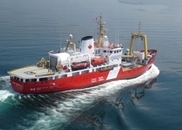
|
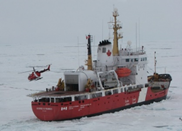
|

|
| Date of Launch |
1985 |
1986 |
1987 |
1985 |
| Introduction |
CCGS Martha L. Black is the lead ship of her class of light icebreakers of the Canadian Coast Guard. The ship was built in 1986 in Vancouver, British Columbia by Versatile Pacific Shipyards Limited as part of the CG Program Vessels. The vessel was mainly designed as a high-endurance, multi-tasked boat. Most of her duties are along the St. Lawrence River and St Lawrence Seaway as she is able to handle the ice thickness there. |
CCGS Sir Wilfrid Laurier is a Martha L. Black-class light icebreaker and major navaids tender of the Canadian Coast Guard. Built in 1986 by Canadian Shipbuilding at Collingwood, Ontario, Canada, she was the last ship constructed there. The ship has been based out of Victoria, British Columbia. |
CCGS Sir William Alexander is a Martha L. Black-class light icebreaker. Entering service in 1987, the vessel is currently assigned to CCG Maritimes Region and is homeported at CCG Base Dartmouth, in Dartmouth, Nova Scotia. The vessel is named after Scottish explorer Sir William Alexander, 1st Earl of Stirling, who was an early colonizer of Nova Scotia. |
CCGS Earl Grey is a Samuel Risley-class light icebreaker and buoy tender in the Canadian Coast Guard. Constructed in 1986, the vessel serves a variety of roles, including light ice-breaking and buoy tending, as well as being strengthened for navigation in ice to perform taskings off shores of the Atlantic coast of Canada. Like her sister ship, CCGS Samuel Risley, she carries a large and powerful crane on her long low afterdeck for manipulating buoys. Earl Grey is the second Canadian service to carry the name. |
| Dimensions(m) |
Length: 83 m
Breadth: 16.2 m
Draft: 6.2 m |
Length: 83 m
Breadth: 16.2 m
Draft: 6.2 m |
Length: 83 m
Breadth: 16.2 m
Draft: 5.9 m |
Length: 69.7 m
Breadth: 13.7 m
Draft: 5.2 m |
| Gross tonnage(ton) |
3,818.1 tons |
3,812.1 tons |
3,727.2 tons |
1,971 tons |
| Icebreaker Engineering Details (from Canada.ca) |
https://inter-l03.dfo-mpo.gc.ca/fdat/vessels/report/84 |
https://inter-l03.dfo-mpo.gc.ca/fdat/vessels/report/100 |
https://inter-l03.dfo-mpo.gc.ca/fdat/vessels/report/101 |
https://inter-l03.dfo-mpo.gc.ca/fdat/vessels/report/57 |




